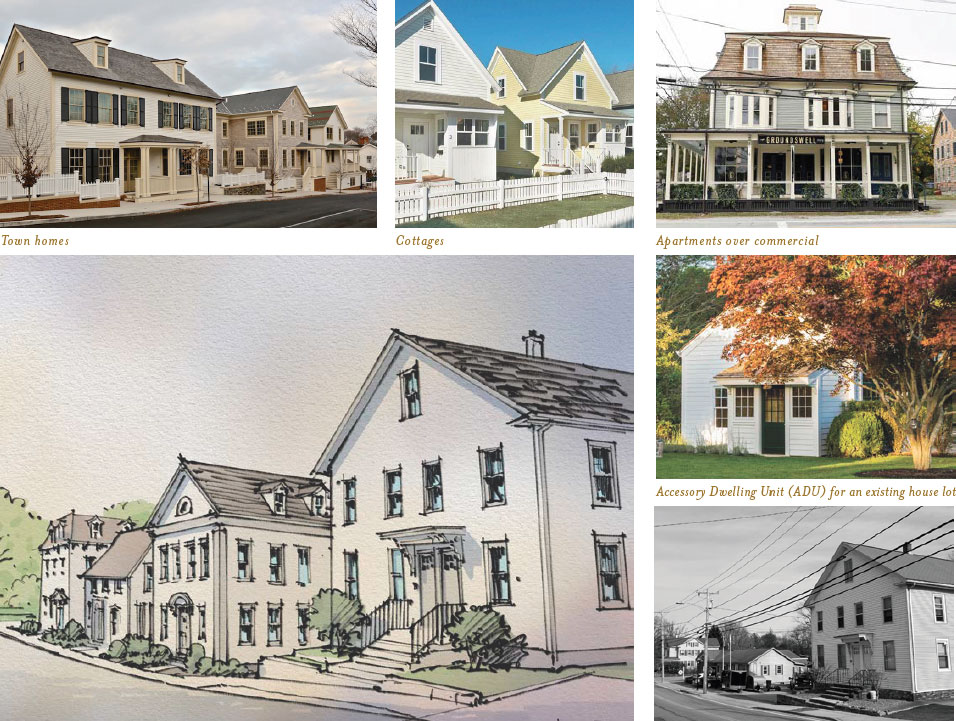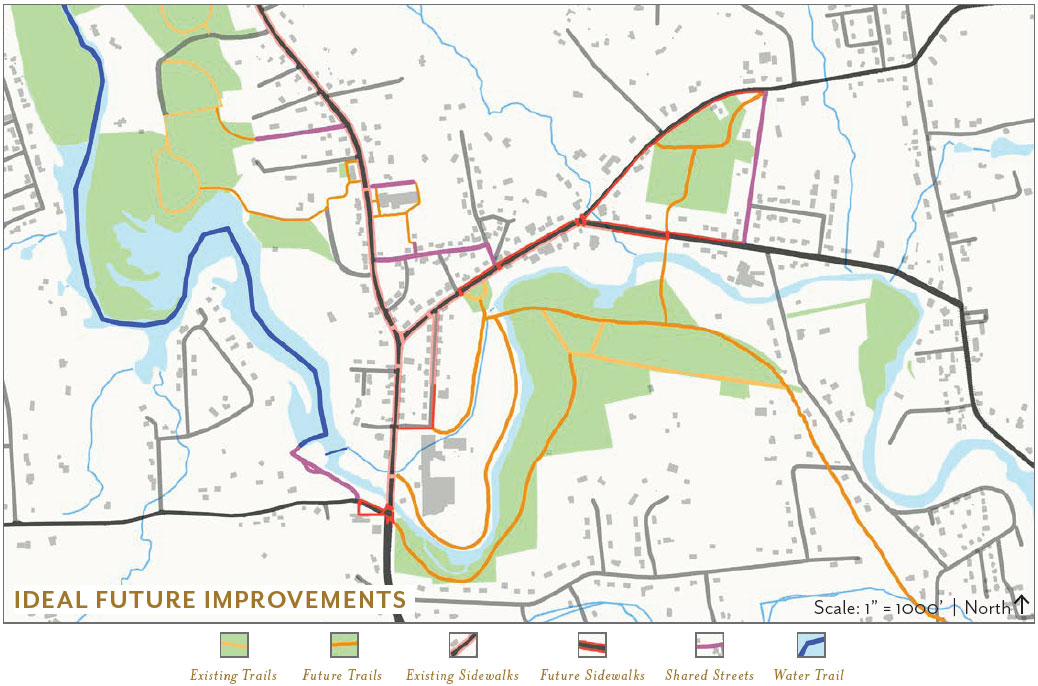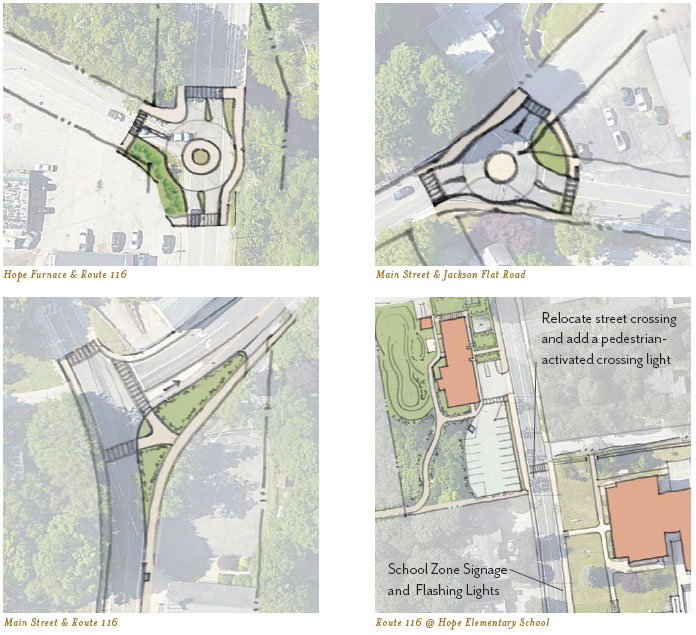
In Hope of growth, a village plans better connections
Hope Village in Scituate, Rhode Island, reached its current size by approximately 1890. The 19th-century cotton mill, which drove the economy for a century, has been closed for five decades, precipitating a slow decline. The village is beloved by many for its small-town atmosphere, but the mill is collapsing, and Main Street is more of a drive-through than a destination. While the village is walkable, the walk is often unpleasant due to speeding traffic, and the village lacks direct connections between many amenities.
“It seems Hope Village is at a tipping point. The status quo is no longer acceptable. So, how should the village grow?” asks Historical Concepts, the planning firm that worked with a village committee on a CNU Legacy Project this year. Legacy Projects leverage CNU’s planning and design expertise to make a long-term impact on the host region of the annual Congress, which was in Providence for CNU 33, held in mid-June.
The project to revitalize Hope, located approximately 10 miles southwest of Providence, emerged from a desire to enhance connectivity, economic growth, and livability in a New England village, specifically in the Providence region. The final report, "Connecting With Hope," demonstrates how enhanced pedestrian connections, combined with policy changes targeting the built environment, can propel the village toward a more positive future. The plan is called Connecting with Hope for good reason—better connections are a key to growth that retains the village’s charm.

Challenges
The report identified challenges that need to be addressed before the village can grow. Addressing all of these would lead to a more connected future.
- Septic/sewer solutions. Residences and businesses are served by individual septic systems, which occupy considerable land and make it challenging to build additions that would provide more housing options. “The alternative is to have a sewer system that serves the village. Tax Increment Financing (TIF) is a common funding mechanism for infrastructure projects of this scale,” the planners report.
- Streets and key intersections. The village has three primary intersections, all of which suffer from speeding and pedestrian safety problems. “Being state routes, the Town of Scituate does not have control over their design, but should work to influence the designs in ways that better achieve stated goals of connectivity and pedestrian safety. While no easy or quick task, the sooner that a group of advocates can engage RIDOT, the better,” the planners explain.
- Hope Mill and Hope Dam. The village’s biggest eyesore and sign of decline is the crumbling mill. Because the mill has been deteriorating for so long, planners report that the preservation of existing buildings is improbable. This judgment was determined through an unbiased expert assessment. Retaining portions of the building or reusing materials is desired by all. Planners advised the village to develop a “wish list,” but not to let the list prevent or delay redevelopment. “Greenlight any redevelopment project,” the planners urge, but any project should include housing. Hope Dam, which is part of the mill property creating Hope Pond, a village asset, should be deeded to the Pawtuxet River Authority & Watershed Council, the report recommends.
- Resourceful solutions for parking. Large community gatherings, church services, and other events pose intermittent parking problems. The team recommends that a few municipally owned lots be provided with pedestrian connections to village assets and amenities.
- Incremental development. Like many communities across the US, affordable housing is affecting the village, and this issue is expected to grow. The team recommended incremental development solutions to preserve village character, facilitated by strategic zoning reform. The team envisions infill of cottages, accessory units, and townhouses.
Plan for connections
Connecting With Hope’s boldest idea is a network of pedestrian paths and improvements that enable the parking plan to work, provide alternatives to automotive travel, and make the village more attractive for economic growth. The team first identified missing and poorly performing links in the transportation network. The networks of streets, sidewalks, and trails in the village are incomplete, raising challenges in getting around by car, bike, or on foot. Nonautomotive travel is particularly challenging.

The planners quickly identified opportunities to create more connections, particularly through trails, sidewalks, and low-volume “shared streets” that allow all modes to mix. “With this vision, one could ride a bicycle from Lippit to Hope Pond and rent a kayak to paddle up the Pawtuxet River. Or a child could more safely walk from the elementary school to Hope Park, avoiding the busiest of streets along the way,” the planners explain.
That sounds like a community that is healthier, more fun, and better functioning. Some of these pedestrian connections would link designated municipal multipurpose parking lots, solving the parking challenge.
Improving the streetscapes is part of the plan to connect the village. The three primary thoroughfares, with their fast traffic and many drivers passing through, currently divide the village. Taming these roads will facilitate the other planned village connections. But this will require sustained pressure on the Rhode Island Department of Transportation (RIDOT), which controls the design.
The design team devised plans for four intersections that, if implemented, would calm traffic throughout the village. That includes two roundabouts as gateways to the village center that would slow traffic to under 20 mph at these points. At the center of the village, a modified intersection with all-way stop signs would calm traffic and make pedestrian crossings easier. Pedestrian cross lights at the school are also recommended.

Zoning recommendations
To facilitate incremental development, planners recommended adjustments to land-use regulations. Such changes are part of a national movement to reform coding and are being implemented in many communities coast to coast, including rural villages. The report says:
- The current zoning code for the town of Scituate limits housing through special permit requirements for dense housing types (e.g. duplexes, triplexes, etc.). We recommend allowing more dense housing types by-right in more zoning districts.
- Current minimum lot sizes and setback requirements make it impossible to replicate the architecture of Hope Village anywhere else in Scituate, which suppresses the village’s growth. So much of the charm of the village’s historic buildings comes from not just their architectural detail, but also how the buildings address the street and their proximity to one another. The zoning code must allow smaller lot sizes and setbacks for Hope Village to grow in a manner that appears natural and maintains its historic character.
- It is important to acknowledge that the town of Scituate’s zoning code’s limits on housing density are with the purpose of protecting the water quality in the Scituate Reservoir and the groundwater which serves most homes in the town. These updates to the zoning code must happen in conjunction with a strategy to address the septic/sewer issue, as outlined in a future section of this document.

During the charrette in March, the planning team completed an interesting hypothetical study. If the village had grown after 1890, what would the block and street pattern look like? Historical Concepts drew a plan that approximately doubles the village's blocks. The plan shows a quaint and small village—but one with more housing and connections. Although this is not the preferred path for the village at present, it could point the way to sustainable growth in the future. Expanding the street grid is an option, not just in Hope but in other villages throughout the US.
Market analysis
The Legacy Project team provided a valuable service to Hope and the Town of Scituate by commissioning a residential market analysis from Zimmerman/Volk Associates, which showed strong potential for in-migration if housing options are made available.
The market is not preventing growth; rather, it is the list of challenges identified by the team. Addressing those will be difficult, but doable, for Hope. If village leaders implement the various aspects of the plan, the 21st Century could be a new century for positive growth, as opposed to another century of slow decline.
“The planning team assembled a responsibility matrix to help the Hope Village Legacy Project Committee to begin to organize efforts around the Initiatives,” Historical Concepts explains. “This is a starting point and should be used as a living document to grow and change with time.”
That’s much like the village itself.







